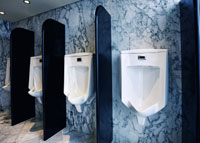Articles
Making Your Restrooms Green and Sustainable
Categories: Innovations, Trends & Technology, Sustainability & ESG
By Robert Kravitz | January 17, 2018 << Back to Articles
Surprisingly, one area often overlooked as a facility becomes greener and more sustainable is the restroom. Yet more water is used in restrooms than virtually any other area of a facility, and because water and energy are interconnected, water consumption increases the amount of energy necessary to power a facility.
In addressing this issue, Waterless Co., Inc. President Klaus Reichardt offers the following suggestions to help make commercial restrooms greener and more sustainable:
- Lighting. Restroom lighting is often on 24 hours a day. Install motion sensors to turn off lights when the restroom is not used.
- Light bulbs. Replace conventional light bulbs with energy-efficient lighting.
- Cleaning. Virtually all products used for cleaning restrooms now have certified green equivalents; consider using only green cleaning chemicals and products.
- Water faucets. Install sensors. Studies indicate sensors that turn water on only when needed can reduce water consumption by as much as 70 percent.
- Hand dryers. A public restroom used by 200 people a day may use enough paper towels to fill a six-foot-tall garbage bag. Provide hand towels or electric hand dryers to eliminate this waste.
- Fixtures. Install fixtures that surpass current government mandates. Some new toilets use 1.28 gallons of water per flush, and no-water urinals save thousands of gallons of water per year per urinal.*
- Recyclables. Station recycling bins in restrooms. Many paper products used in restrooms can be recycled.
- Leaks. Search for leaks and fix them. Just one faucet dripping intermittently can waste three gallons of water per day—or up to 1,095 gallons a year.
“Restrooms are highly visible areas,” adds Reichardt. “A green and sustainable restroom shows a facility is doing more than talking green, it’s making green and sustainable part of the way it does business.”
*Current U.S. government regulations require that toilets use no more than 1.6 gallons of water per flush and urinals about one gallon per flush.

About the Author.
A former building service contractor, Robert Kravitz is president of AlturaSolutions Communications, a Chicago, IL-based firm that provides corporate communication services to organizations in the jansan and building maintenance industries. He can be reached at [email protected].





